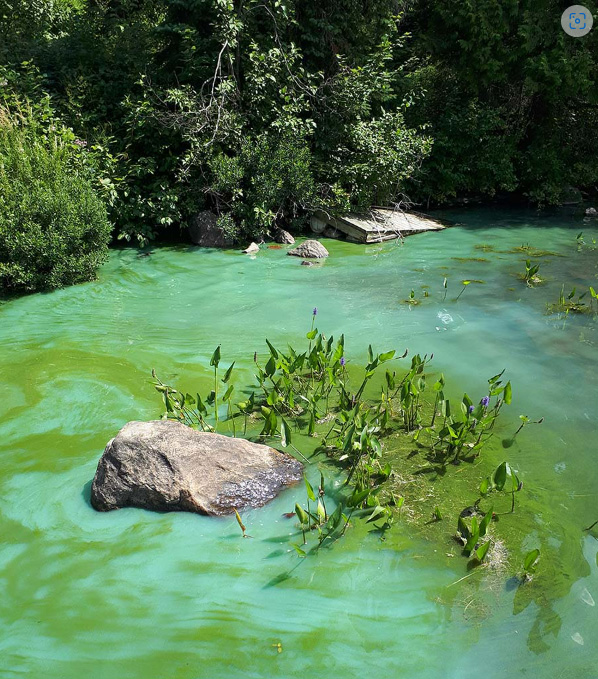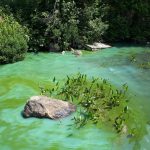Waterborne Pathologies – Harmful Algal Blooms and Cyanobacterial Toxins

What is pathology?
At its core and most basic definition, pathology is the study of infectious organisms and their impact on human health. In a very broad sense, pathology encompasses all human infections and the complications and diseases they cause. It focuses on “pathogens”, the unit of infection, be it the tetanus bacteria that enters the bloodstream after stepping on a rusty nail, or the COVID virus that can enter your lungs if someone infected were to cough on you. These are both “pathogens”, and pathology is the study of these things and how the human body responds to them.
Of course, this general definition is far too broad and covers far too many of these pathogens, and so we can narrow them down into smaller groups. One of these ways you can do this is by discussing how they can be spread and transmitted. Waterborne pathogens are those which pass to humans using water as its medium of transport. In the urban areas of countries like Canada, we have extremely thorough water treatment methods which have led to much lower levels of contamination in the water we drink and bathe in. This does not mean we are free from these microscopic critters that can cause us harm. An example of a waterborne pathogen that is widely prevalent in Canadian waterways despite thorough water treatment, is Cyanobacteria.
What are Cyanobacteria?
| Cyanobacteria, commonly known as “blue-green algae”, are a form of bacteria categorized as phototrophs; able to perform photosynthesis, one of the foundational chemical processes that keeps our world oxygenated. These Cyanobacteria are one of the most efficient and largest groups of phototrophic prokaryotes, and they account for approximately 25% of global carbon fixation (the process in which carbon dioxide is converted into organic compounds). They are also responsible for the first ever creation of oxygen in our atmosphere when they appeared on the scene 2.3 billion years ago [i], and their extraordinary talent for producing oxygen initiated one of the first mass extinction events in our Earth’s history [ii].
Nearly all the organisms around during that time were anaerobic, meaning they survived without the use of oxygen, since there had never been oxygen in the atmosphere before. When these little algae began mass producing oxygen, it started to react with the other components of our atmosphere, and before long, it almost entirely replaced the methane (a greenhouse gas) which had been keeping the planet warm as an insulator. This was known as the Great Oxidation Event, and the planet cooled to a point where ice sheets spread from the poles of the planet all the way to the tropics; these bacteria had directly caused one of the first ice ages. |
All this is to say, these microorganisms have one of the most significant impacts on our world both historically and currently. They are crucial to regulating carbon waste and oxygen in our ecosystems, and their utility has been well respected with researchers beginning to use them in the production of renewable biofuels [iii]. However, they also pose a risk to humans in the form of “harmful algal blooms”. Typically, algal blooms are beneficial to aquatic ecosystems as they can produce an abundance of biofuels to be consumed by all manners of creatures. They can become harmful to not only aquatic organisms, but also to humans as they can contaminate the water we drink and swim in. Cyanobacteria are not pathogens themselves. When they die, they release toxins which are the pathogenic culprits that contaminate water and cause harm to humans [iv].
Prevalence in Freshwater Systems – What do they love to grow in?
So now that we have a collective understanding of what Cyanobacteria are, we can dive into the type of environments they love to thrive in . These bacteria, like any other organism, thrive where there is an abundance of nutrients and food for them to consume. In their case, they are particularly prevalent in waterways where there is a high concentration of nitrogen and phosphorus [v]. Lakes regulate the concentration of these nutrients by retaining a certain percentage within their waters, with the rest being dispersed through other organisms or lake sediment (see image below). This regulatory cycle, known as the phosphorous cycle, is not always stable, and can be disrupted by several different factors like climate, pollution, or water contamination by humans [vi]. When this biogeochemical cycle is disrupted and we end up with a large increase in nutrients in lakes, it‘s called eutrophication. These bacteria also love slow moving water bodies, like lakes, and higher water temperatures [vii]. When the waters are slow moving, it allows the Cyanobacteria to pool together, collecting at the surface of the waterway. If these waters were to become rougher, these bacteria would be separated and spread out, partially decreasing their bloom potential.
| When you combine these factors (excess nutrients, slow moving/stationary water, high temperatures), you have the perfect environmental conditions for a harmful algal bloom. It is understandable, then, why these algal blooms have been increasing over the past decades. Climate change has led to an increase in the global average temperature, causing lakes to rise to higher temperatures in the summer months. Additionally, studies have shown that in Ontario, algal blooms are most common in areas where there is substantial overlap of humans and lakes, with a lower prevalence in less populated areas [ix].
It is important to remember, algal blooms are naturally occurring, were around long before humans started polluting waterways and can be beneficial to water ecosystems. However, due to increasing external factors they can become harmful, not only to us, but to the aquatic ecosystems they have helped to build. |
 The phosphorus cycle. Source: Dickenson, L., 2022, Back to basics: How and why phosphorus cycles through a lake. |
Human Health Impacts
Understanding the risk the bacteria can pose to humans is critical, especially considering these harmful algal blooms can occur in lakes in areas with high human use. It could be a favourite lake for locals to swim in during the summer months to provide a reprieve from the heat. Independent research agencies and local governments work hard to continually monitor lakes to ensure advisories are mass distributed with proper warnings [x]. Canada has more lakes than any other country in the world [xi], and therefore it can be difficult to constantly monitor every at risk lake.
As per the government of Canada Health Services, exposure to Cyanobacteria toxins can occur through the following [xii]:
- Swallowing contaminated water
- Skin contact
- Breathing in water drops that contain toxins
These are all results of recreational use of waterways containing blooms. The symptoms of exposure can be extremely varied and include the following:
- Skin, eye, nose, and throat irritation
- Stomach pain, diarrhea, and vomiting
- Headaches, muscle weakness, and fever
With only a few cases reported worldwide, exposure can be fatal to humans. I say this with a heavy emphasis on its rarity. It is important to note that animals (e.g. pet dogs) are more susceptible to fatalities from these toxins than humans, so make sure to avoid these waterways entirely if possible and keep animals well under control.
Cases in Canada – How to recognize a bloom
As mentioned, reports of harmful algal blooms have increased over the past few decades [xiii], caused by a number of factors. Lake Winnipeg has been one of Canada’s lakes with the highest recurrence of algal blooms. It has been called “Canada’s sickest lake” and “the most threatened lake in the world” due to its susceptibility to eutrophication [xiv]. Meanwhile in Alberta, the Alberta Health Services has issued more than 30 Cyanobacteria health advisories for different lakes and reservoirs across the province since June 5th of this year (2024) [xv].

Figure 3: A graph depicting the number of algal blooms reported and confirmed in Ontario from 1994 to 2019 [xvi]
- The form for Alberta can be found here [xviii].
- The form for BC can be found here [xix]
- The form for Ontario can be found here [xx]
- For more information on identifying these blooms, you can visit this site [xxi].
Conclusion
To conclude, Cyanobacteria are magnificent and complex microorganisms crucial to the management of our ecosystems and were one of the founding pillars which allowed for aerobic life on Earth to develop and thrive. We owe them a debt of gratitude best paid by limiting the pollution of water bodies, ensuring they do not grow out of control and cause harm to ecosystems and humans. Prevention over treatment is always the preferred method of dealing with pathogens. Remember to avoid algal blooms and report them if seen. Let’s be responsible with our precious lakes and ensure that the generations to come can enjoy them as we have.
Author
Brendan Bate. Recently I graduated from Queen’s University, achieving an undergraduate degree in Life Sciences and Economics with a focus on pathology and microbiology. I have been working as an intern for the Alberta WaterPortal for the past few months.
Sources
[i] Mehdizadeh Allaf, M., & Peerhossaini, H. 2022, Cyanobacteria: Model Microorganisms and Beyond. Microorganisms, 10(4), 696. https://doi.org/10.3390/microorganisms10040696. Accessed 2024-08-28
[ii] Aiyer, K., 2022, The Great Oxidation Event: How Cyanobacteria Changed Life. https://asm.org/Articles/2022/February/The-Great-Oxidation-Event-How-Cyanobacteria-Change. Accessed 2024-08-28
[iii] Mehdizadeh Allaf, M., & Peerhossaini, H. 2022. Cyanobacteria: Model Microorganisms and Beyond. Microorganisms, 10(4), 696. https://doi.org/10.3390/microorganisms10040696. Accessed 2024-08-28
[iv] Mehdizadeh Allaf, M., & Peerhossaini, H. 2022. Cyanobacteria: Model Microorganisms and Beyond. Microorganisms, 10(4), 696. https://doi.org/10.3390/microorganisms10040696. Accessed 2024-08-28
[v] Government of Canada, 2024-06-13, Recreational water and health: Cyanobacteria and their toxins. https://www.canada.ca/en/health-canada/services/environment/recreational-water/cyanobacteria-toxins.html#a2. Accessed 2024-08-28
[vi] Dickenson, L. 2022, BACK TO BASICS: How and Why Phosphorus Cyckes through a lake. https://www.iisd.org/ela/blog/back-to-basics-how-and-why-phosphorus-cycles-through-a-lake/. Accessed 2024-08-28
[vii] Government of Canada, 2024-06-13, Recreational water and health: Cyanobacteria and their toxins. https://www.canada.ca/en/health-canada/services/environment/recreational-water/cyanobacteria-toxins.html#a2. Accessed 2024-08-28
[viii] Dickenson, L. 2022, BACK TO BASICS: How and Why Phosphorus Cyckes through a lake. https://www.iisd.org/ela/blog/back-to-basics-how-and-why-phosphorus-cycles-through-a-lake/. Accessed 2024-08-28
[ix] Favot, E. J., Holeton, C., DeSellas, A. M., & Paterson, A. M. 2023, Cyanobacterial blooms in Ontario, Canada: continued increase in reports through the 21st century. Lake and Reservoir Management, 39(1), 1–20. https://doi.org/10.1080/10402381.2022.2157781. Accessed 2024-08-29
[x] Government of Canada, 2020-09-01, EOLakeWatch: Remote sensing of algal blooms. https://www.canada.ca/en/environment-climate-change/services/water-overview/satellite-earth-observations-lake-monitoring/remote-sensing-algal-blooms.html. Accessed 2024-08-25
[xi] Government of Canada, 2013-09-09, Water sources: lakes. https://www.canada.ca/en/environment-climate-change/services/water-overview/satellite-earth-observations-lake-monitoring/remote-sensing-algal-blooms.html. Accessed 2024-08-25
[xii] Government of Canada, 2024-06-13, Recreational water and health: Cyanobacteria and their toxins. https://www.canada.ca/en/health-canada/services/environment/recreational-water/cyanobacteria-toxins.html#a2. Accessed 2024-08-28
[xiii] Stephen S. Bates et al., 2020, Marine harmful algal blooms and phycotoxins of concern to Canada. https://publications.gc.ca/site/eng/9.888345/publication.html#:~:text=%22In%20Canada%2C%20reports%20of%20marine%20harmful%20algal%20blooms,phytoplankton%20that%20produce%20phycotoxins%20or%20otherwise%20cause%20harm. Accessed 2024-08-26
[xiv] Ali, G., 2019, Phytoplankton blooms in Lake Winniped linked to selective water-gatekeeper connectivity. https://www.nature.com/articles/s41598-019-44717-y#citeas. Accessed 2024-08-28
[xv] Alberta Health Services, 2024, Cyanobacteria (Blue-Green Algae) Health Advisories. https://www.albertahealthservices.ca/news/bga.aspx. Accessed 2024-08-28
[xvi] Favot, E. J., Holeton, C., DeSellas, A. M., & Paterson, A. M. 2023, Cyanobacterial blooms in Ontario, Canada: continued increase in reports through the 21st century. Lake and Reservoir Management, 39(1), 1–20. https://doi.org/10.1080/10402381.2022.2157781. Accessed 2024-08-29
[xvii] Government of Canada, 2023-03-07, EOLakeWatch: Annual algal bloom summary reports. https://www.canada.ca/en/environment-climate-change/services/water-overview/satellite-earth-observations-lake-monitoring/annual-algal-bloom-summary-reports.html. Accessed 2024-08-25
[xviii] Contact Environmental Public Health · Alberta Health Services
[xix] Report All Poachers and Polluters (RAPP) – Environmental Protection & Sustainability Forms (gov.bc.ca)
[xx] Report Pollution | Ontario.ca (gov.on.ca)
[xxi] Ontario, 2024-04-02, Blue-green algae. https://www.ontario.ca/page/blue-green-algae#section-1. Accessed 2024-08-25

